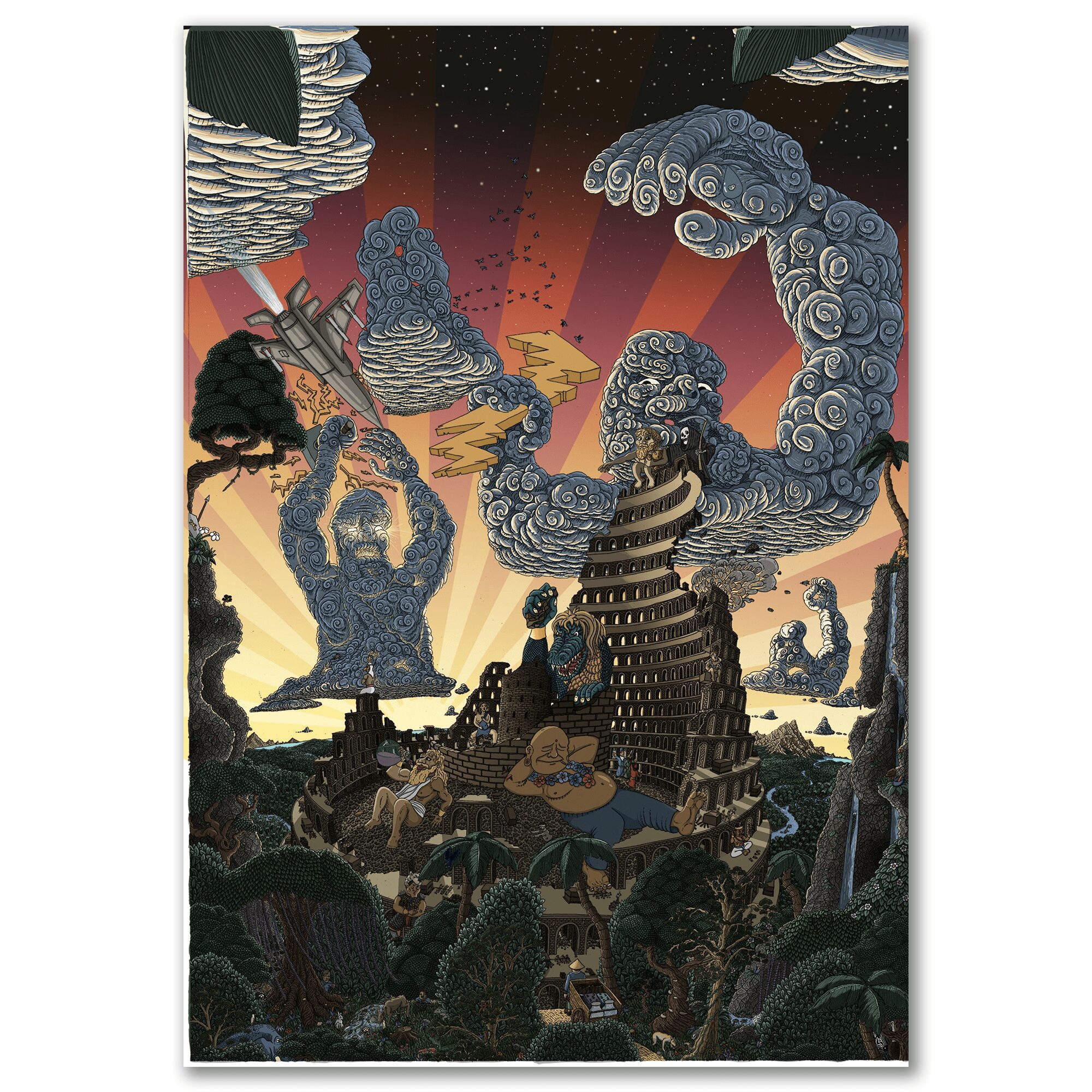Description
The tower of Babylon occupies the center of the picture. This is the biblical story of
how God gave humans different languages and therefore could not cooperate. Christianity
is only one of many belief systems on planet earth, but a religion, in general, can create
division between people which in turn makes us unable to cooperate. In nature, on the
other hand, cooperation is natural in nature, even between species.
Ravens and wolves cooperate by the raven’s ability to spot prey from high up in the
sky. The raven dives down and marks the prey. The wolf then in turn kills the prey, before
they share the meal. There are many other examples of cooperation between species, like
Zebras and Ostriches where the Zebra has good vision and bad hearing, while the Ostrich
has good hearing and bad vision. Together they are better equipped to discover hungry
predators. There are also trees that cooperate with ants, the tree lets the ants live
inside the tree, in return the ants’ attack intruders who feed on the tree. The tree sends
out sent signals about the whereabouts of the intruders and the ants’ attack.
About 650 million years ago, there were only single-celled organisms like bacteria
on planet earth. One day a small bacteria penetrated a larger cell and started to eat the
waste material of the bigger cell. The small bacteria had its own waste, which was nutritious for the
bigger cell, this way the cell gained more energy and started to divide. This is how
multiple-celled organisms started to evolve. In each cell in all living creatures on earth
today, we find this small bacteria called the Mitochondria bacteria. This is the power
plant of the cell, and without this, humans would not exist today. Cooperation is therefore key to life
on earth.
To underline that gods are made by man and the other way around, you find seven
gods performing the seven deadly sins on the tower of Babylon. They all originate from a
time before Christ, but they all have a similar story as Jesus. Buddha, Krishna, and Horus
are all among the sinners. Especially Horus has an identical story as Jesus. He was born
by a virgin mother, the three wise men came to visit, he healed the sick, was crucified with
two bandits, was resurrected on the third day, before he went up to heaven after forty
days. This implies that the story of Jesus is plagiarized, told throughout centuries. There
are theories that state that the story is describing the path of the sun over the sky, past the
twelve-star constellations which the Babylonians invented six thousand years ago.
Jesus himself is visible on top of the crumbling tower. He represents the explanation
of how religion occurred. First and foremost he is scared of death. This is the foundation of
all religion. The fear of death is great and man has always fantasized about life after death.
At the same time, we have a profound wish to see our loved ones again on the other side.
Jesus clutches a teddy bear, which represents two things. The first is that almost
all religious people have got their belief from their childhood. Their parents have told them
stories of the bible and other holy scriptures, and they have in turn believed them. Childhood
faith sticks with them through life, especially if people they trust have the same beliefs.
The teddybear also represents a personification of an object. When you are a child
it is easy to get attached to a teddy bear or a doll. You give the object a personality and
reveal your deepest secrets to this object. It can be hard to detach yourself from the object
later in life because of the emotions invested in the relationship. The object can still be
perceived as a living thing and therefore hard to get rid of. Similarly, people create a
personification of God. Even though God is an abstract term only exciting in the collective
conciseness of humans, people will attach a personality to this fictive person, and create a
strong bond to him. Like the teddybear, it is hard to let go of the attachment, even as an
adult.
There is an experiment which you can do on pigeons called «Pigeon superstition».
The experiment consists of putting a pigeon alone in a box, feeding it through a computer
at random times. The pigeon will evolve a pattern which it thinks is the reason it receives
food. What the pigeon did the first time it received food, will determine the pattern. The
pigeon will repeat the pattern expecting more food. One example can be turning 360
degrees to the left, jumping and then a 360 degree turn to the right, ending with flapping the
wings.
This experiment underlines how natural it is for living creatures to look for patterns
in nature. Similarly, humans have evolved their religions, ceremonies, and rituals throughout time. Humans have seen a connection between their actions and events occurring in
nature and society.
Today we bomb the old Babylonian empire to shreds, while Norwegian companies
get rich on war material. We humans must look past our differences like language and
religion to realize that we are all better at cooperating with each other. We all originate
from the same cells that once floated around the ocean, seeking nutrition from the sun.
(text by Guttestreker)




